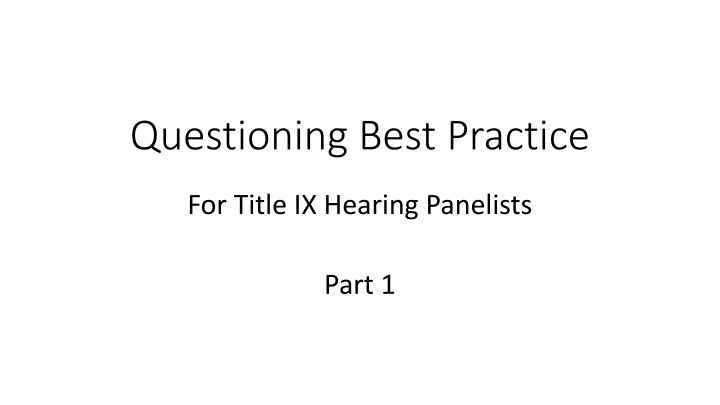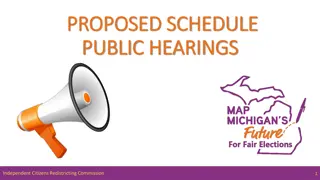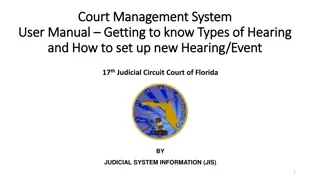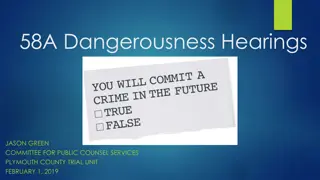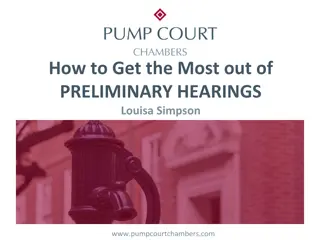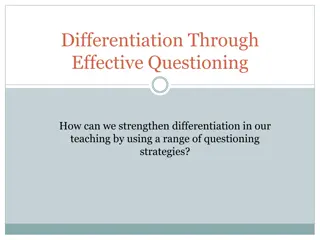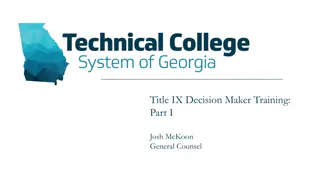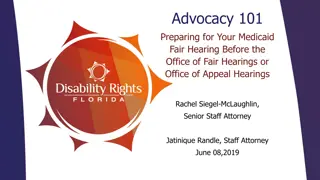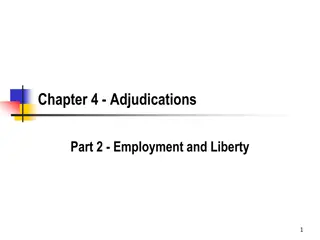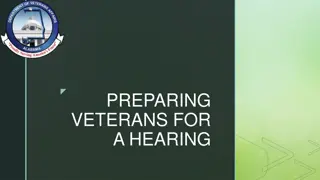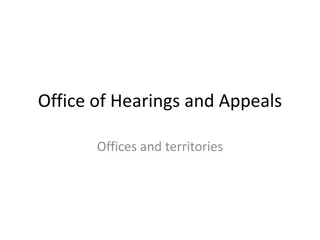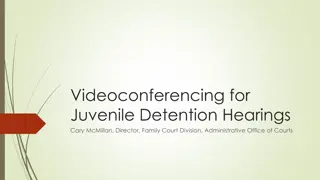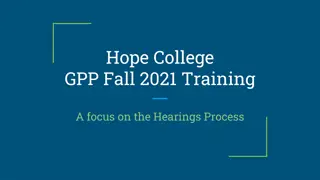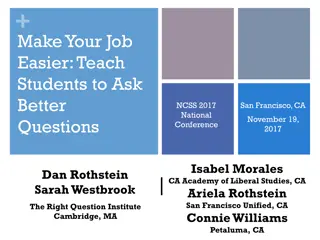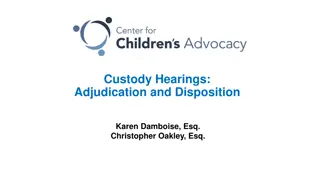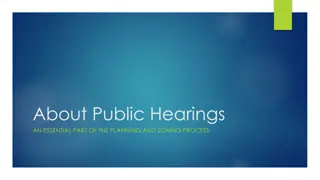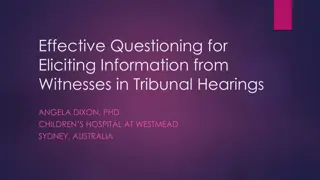Strategies for Effective Questioning in Title IX Hearings: Part 1
Learn evidence-based questioning strategies to engage parties and witnesses effectively in Title IX hearings. This includes creating a questioning plan, practicing empathy, cultivating rapport and cooperation, active listening, addressing discrepancies, and avoiding unproductive techniques. Utilize the funnel technique, examine the goal of interviews, and make a questioning plan focusing on eliciting credible information while remediating prejudice and stereotypes.
Download Presentation

Please find below an Image/Link to download the presentation.
The content on the website is provided AS IS for your information and personal use only. It may not be sold, licensed, or shared on other websites without obtaining consent from the author.If you encounter any issues during the download, it is possible that the publisher has removed the file from their server.
You are allowed to download the files provided on this website for personal or commercial use, subject to the condition that they are used lawfully. All files are the property of their respective owners.
The content on the website is provided AS IS for your information and personal use only. It may not be sold, licensed, or shared on other websites without obtaining consent from the author.
E N D
Presentation Transcript
Questioning Best Practice For Title IX Hearing Panelists Part 1
Part 1 Overview GOAL: Learn evidence-based strategies for questioning parties & witnesses 1. Make a questioning plan 2. Practice empathy 3. Cultivate rapport & cooperation 4. Listen actively 5. Address discrepancies 6. * Avoid unproductive questioning techniques * 7. Utilize productive questioning strategies The Funnel Technique QUIZ & PRACTICE
The Goal of the Interview The goal of the interview is to elicit cooperation through rapport- building and questioning techniques that lead to the recall and disclosure of credible information in a way that remediates stereotyping and prejudice.
1: Make a Questioning Plan Step 1/3 Self-check for stereotyping & prejudice Limit extraneous and non-material information TIX bias/conflict of interest training Identify stereotypes Prejudice remediation Step 2/3 Identify what information you are eliciting from each person People, location, activities, time, capabilities, opportunities, motivation AIMS: Corroboration & Contradiction
Making a Questioning Plan Step 3/3 Draft Questions 1. Avoid prejudicial language Partiality: I m sorry this happened to you, you re not to blame, closure Pre-determination: sexual assault, sex, sexual activity Prejudice: victim, survivor, perpetrator, offender, trauma Use neutral language ( incident, conduct, behavior ) 2. Ask for clarification ( hooked up, chilled, messed around ) 3. Helpful things to say If I ask a question you don t understand, please tell me If I don t ask you about something that you think is important, let me know If you think I ve misunderstood anything you say today, please tell me
2: Practice Empathy Empathy refers to the ability to understand the perspective of, and appreciate the emotions of, another person Strategies: 1. Open-ended questioning 2. Communication behaviors Non-verbal body language, proximity, eye contact, nodding Paraverbal speech delivery: tone, pace, pitch, volume warmth, genuineness Verbal content 3. Empathic responses to testimony Validation Mirroring Affirmation Limit-setting create environment of safety for W Interruption seems to be way W can express how they feel encouraging W to express feelings in another way
3: Cultivate Rapport & Cooperation Rapport refers to a productive working relationship between interviewer and interviewee toward a mutually-understood goal Rapport Cooperation Disclosure Rapport-building strategies: Competence Integrity Candor Acts of hospitality Summaries
4: Listen Actively Listening posture leaning, nodding, responsive facial expressions, eye contact, open body language, comfortable proximity Conversation encouragers Encouragers Please continue, Are you comfortable sharing more? Repeat W: When I saw the car coming, I was so scared I: Scared? Echos W: It was the longest, hardest day ever I: You were tired? ;
5: Address Discrepancies Watch for discrepancies in W s account (shifting timelines, different facts or claims) (1) Identify the discrepancy as a point of confusion, and (2) request clarification I appreciate you sharing your story about how you and the Respondent met for the first time two months ago. Witness W told the investigator that she introduced you to the Respondent two years ago. Can you provide some clarification about this? I m confused. You told the investigator that you were not in the car with Jae. But you just stated that you were in the car with Jae. Could you please help me understand this discrepancy?
6: * Avoid Unproductive Questioning * 1. Inappropriate Closed Questions can only be answered yes/no 2. Forced Choice Questions force choosing from either/or options 3. Leading Questions message that a conclusion has already been made 4. Multiple, compound, overly-long questions confusing, combines forced choice + closed
7: Use productive questioning strategies IDENTIFY what piece of information you want to elicit Free Recall Open-Ended: TED Probing: The Ws Appropriate Closed SUMMARIZE: Briefly summarize information the witness has shared
The Funnel Method 1. Identify what information you want to elicit from each W 2. Free recall open-ended Qs 1. TED: Tell, Explain, Describe 3. Probing the Ws (who, what, where, when, how) 1.Defining ( sexual assault, hooked up, stalked, harassed, made out ) 2.Sensory see, hear, smell, feel, taste 3.Question Framing 1. What do you do at UC? Tell me about your role on campus 2. Why didn t you leave What impacted your decision-making? 3. Did you try to push Respondent off How were you responding when 4. Appropriate Closed clarification & verification 5. Summary brief encapsulation of what W said 1.W s exact words/information 2.Exclude inferences/information that could be suggestive or leading 3.Give W opportunity to add/clarify/revise
The Funnel Method Free Recall: Can you share with me what brings you to our office today? Open-Ended Tell me about last Friday night Explain how you met Respondent Describe what happened in Respondent s apartment Probing Who else was there? What can you tell me about the bedroom? Where on your breast did Respondent place their hand? When did leave the apartment? Why do you think they said you were not there? How did you get from the kitchen to the bedroom? Appropriate Closed You shared that Respondent was holding a knife. In which hand? You shared that Respondent was also in the dining hall. Where was Respondent situated in the dining hall? Summarize
Quiz Identify the following as open-ended, inappropriate closed, forced-choice, leading, or compound 1. Do you know the Respondent? 2. Is that when your roommate walked in? 3. And then your roommate walked in, right? 4. Do you live by yourself or with a roommate? 5. Do you remember getting the Complainant s phone number? 6. Tell me what happened next. 7. Was your relationship with the Complainant romantic, friendly, or collegial?
Make these questions productive Re-word the following in order to elicit more information from the party: 1. When did you and the witness meet? 2. Did you ever communicate your boundaries to the Complainant? 3. Did you and Complainant engage in physical touching after you broke up? 4. Were other students around when Respondent said this to you? 5. Did the conversation with your instructor make you mad? 6. Did the Complainant say anything to you after you kissed?
